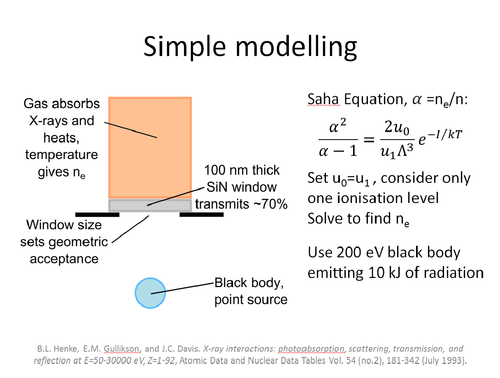There hasn’t been much science done on MAGPIE since the end of February. After the upgrade to our lighting, we found the machine wasn’t behaving properly, and decided to refurbish all four Marx banks. Even that didn’t work, and we went back into the one particularly troublesome bank to try and fix that – we’ll find out if we were successful next week.
Time has, however, been moving onwards with no regard for my inability to take new data, and now I have two conferences to go to in the next few weeks: Firstly, HEDLA (High Energy Density Laboratory Astrophysics) in Bordeaux, and then a fortnight later to ICOPS (International Conference on the Physics of Shocks) in Washington DC. I am presenting a poster at both conferences – it’s likely to be an identical poster given that I only have a week in between conferences.

One of my slides for my poster presentation. The red squiggles hopefully didn’t print. If you want some good bed time reading, I highly recommend the reference at the bottom of the slide.
So, what can you put on a poster when you have no data? Well, it’s not as bad as that really – I’ve done a lot of modelling work, which, rudimentary as it is, shows there might be a reason to hope the experiments will show something interesting. I also have some preliminary data which hints at why the experiment might not work so well. Sadly, one thing I can’t really put on a poster is what I’ve actually been working on for the last three months, trying to get MAGPIE fixed.
My poster is quite simple – it’s just a bunch of powerpoint slides that I’ll arrange on the poster board I’m allocated. I have made nice posters in A0 or larger sizes before using Beamer, but they are hard to transport, so this time a series of A4 sheets seemed like a better idea. The first draft had quite a lot of text, but my advisor, Sergey, advised me that no one looks at text, and I replaced almost all the writing with an equivalent picture, diagram or figure. There are two poster sessions at HEDLA, so I’ll be standing by my poster then, waiting to explain it to anyone who wanders by and looks vaguely interested.
What I’m really hoping to get out of these conferences is contacts. Collaboration in science is very important, and in particular I want to make contact with someone who has a powerful computer code (and the computing resources to run it on!) which can simulate the physics involved in these experiments. My simple models are definitely wrong, but I don’t have the skill or the time to implement something better. Hopefully my poster looks intriguing enough to attract the attention of a simulations expert looking for some experimental validation of their code.
This blog has actually been invaluable in getting my poster prepared – many of the images I made for the blog are on the poster, as they are good, simple diagrams that show what I’m trying to do. I haven’t been blogging much recently because there’s been little new to write about, but I’m hoping June and the long, distraction free summer brings me some success.